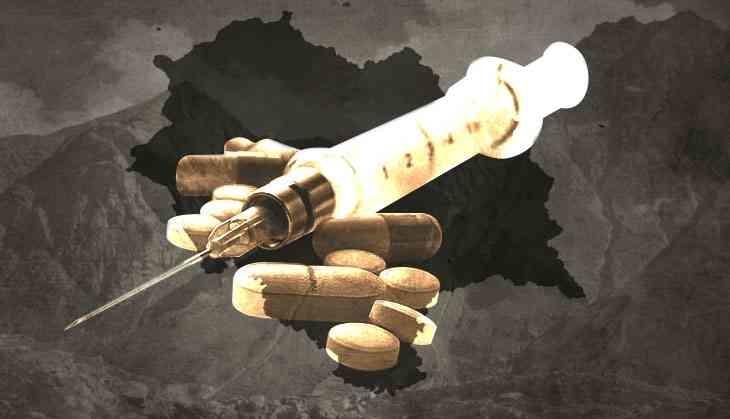Himachal Turning into a Synthetic Drug Haven?

While Himachal Pradesh has been infamous for producing world-famous marijuana and charas that have been finding way across the country and even abroad for decades, the situation has worsened with the entry of synthetic drugs into the hill state from across the shared borders of the neighbouring states like Punjab. An alarming trend of increased drug abuse among the youth of Himachal Pradesh in recent years has caused a stir among the masses, but a concrete plan and interventions to tackle the menace by the government and the authorities are missing.
Youngsters in the state, including those in school and colleges are not only getting addicted to cigarette and tobacco, but they are also falling prey to capsules, shoe polish, cough syrups, balm, along with charas, smack, opium and heroin.
The natural narcotic substances are cannabis, illegal cannabis and illegal opium, while cough syrups and capsules are “prescription-based” psychotropic substances. O P Sharma, former superintendent, Narcotics Control Bureau, Chandigarh, said, “The gateways for these drugs and psychotropic substances among the consumers are chemist shops, even internet and people who create their market among children to spread the use of these substances or simply peddlers.”
He further added that these drugs are not only manufactured in the state, but also find their way into the state from across the shared borders with states like Punjab. Methamphetamine or the infamous chitta, which is derived from adulterating heroin to make it more potent, is largely produced in Punjab, and has also made its way into the state.
Chief Minister Jai Ram Thakur had recently issued a statement, which said that drug abuse was a social vice, which needed to be curbed with public participation, and it was unfortunate that 27 per cent youth in the state were involved in the drug problem. Interestingly, these figures do not represent the ground reality, as there are no studies undertaken by the government. The actual figures are likely to be much higher, according to former DGP, I D Bhandari, which highlights the longstanding demand for a government-backed audit of the numbers, social-backgrounds, age group and areas of highest concern.
Need for a social audit
With no government survey available, rise in consumption can be only observed in the way it is manifesting itself: increasing crime rate, increasing school and college dropout rates, low productivity, domestic violence, accidents and the ever increasing demand for relevant health care and rehabilitation services.
According to sources, earlier this year, a 17-year-old from Dangoli village of Una district had died due to overdose of chitta. This was not the first such case; multiple cases had been registered in the district before. In the districts Kullu, Mandi, Chamba, Una, Sirmour and Kangra (bordering Punjab), many locals are witnesses to youngsters taking injections. Many shopkeepers in these districts have stated that they noticed a rising demand for “silver foil” or aluminium foil from young children. Another important issue, which surrounds this addiction, is the social stigma attached to it, which discourages families from reporting the cases of drug abuse. At present, only three districts of Himachal have drug de-addiction centres, which provide counselling and other services to people to give up drug abuse. The remaining nine districts still remain under-covered. Recently, a doctor had told a local reporter that drugs prescribed for medical purpose are difficult to get at the hospitals and pharmacy shops near hospitals, but are easily available near schools and colleges. Some also believe that the smugglers from Pune, Mumbai, Bengaluru and Delhi resort to barter synthetic drugs for hashish or marijuana from the state.
Is the government doing enough?
O P Sharma has been advocating that the states facing the drug menace need to set up an autonomous Narcotics Control Board that has extremely professional members who are experts in banking, finance, legal affairs, policing and enforcement. “This board can monitor the line agencies and ensure that those trapped (in smuggling) are not able to evade conviction.”
He further advocates the need for an Inter-state Anti-drug Vigilance Bureau having officers of the ADGP rank as members to monitor drug movement and provide inputs to the state-level Narcotics Control Boards to act on the ground.
Reports carrying the number of seizures of the drugs are mostly limited to that of a couple of grams, while the influx is much higher in number. “Police are busy organising marathons against drugs and holding anti-drug awareness programmes. But their duty is to catch the perpetrators and not create awareness. That is the government’s duty. Does this mean that the police force is incapable of performing their duty or are they trying to shelter the influential people involved in smuggling?” questioned Sharma.
Sharma alleged that his continuous appeal to the government to set up an Inter-state Anti-drug Vigilance Bureau has not been paid heed to because two sitting MLAs as well as other politicians have a direct role in the smuggling of the drugs. Therefore, the government is continuously just launching awareness programmes rather than busting drug rackets and seizing a contraband’s consignment.
Despite the “anti-drug” poll rhetoric of the BJP in the 2017 assembly elections and Prime Minister Narendra Modi's attack on the "drugs mafia" during his rally while campaigning for elections in the state, government has done close to nothing regarding the influx of the drugs as well as the rehabilitative measures.
Get the latest reports & analysis with people's perspective on Protests, movements & deep analytical videos, discussions of the current affairs in your Telegram app. Subscribe to NewsClick's Telegram channel & get Real-Time updates on stories, as they get published on our website.
























